Subscribe to blog updates via email »
January 2024 Income Report
To listen to an audio version of this report, join the Patreon »
January’s revenue was $6,561, down from December’s $6,631. Profits were $2,815, down from December’s $4,424.
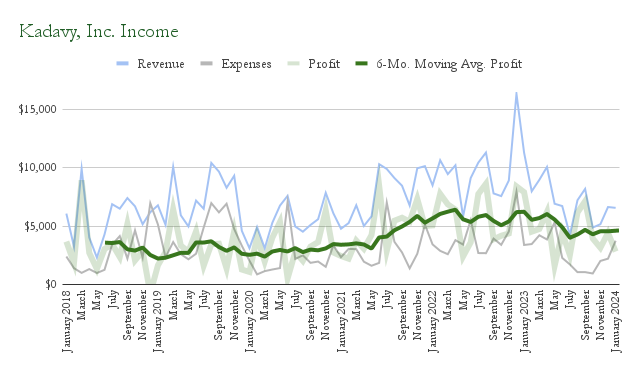

WANT TO WRITE A BOOK?
Download your FREE copy of How to Write a Book »
(for a limited time)
Revenue wasn’t so bad, but expenses were higher than usual. However, profits aren’t a direct reflection of performance this month. I paid for a BookBub Featured Deal that took place in February, and I spent a lot on Meta Ads as I search for my footing with my direct-sales efforts.
Re-modeling
I’m currently feeling more optimistic about my revenue prospects than in recent months. Mostly because I feel like I’m doing something about it. I’m in a more exploratory phase in my current book project – more on that later – and that has freed up some of my creative energy to think about and work on some things I’ve been actively ignoring for months and even years.
The “profit problem”
Basically, I have a profit problem right now, and instead of waiting for my next book to be finished, I’m exploring ways to fix that problem right now. I’m re-“modeling” my business. Trying some different things and ways of using my resources to see if I can settle in on something that works in a sustainable way.
For a few years, I had a nice, repeatable model of testing out ideas on Twitter, developing them into newsletters, podcast episodes, and books, and promoting those books profitably through Amazon Ads. But that model isn’t working so well anymore and not just for me.
I already quit the podcast and so have some left over time and energy. Until recently, that energy had mostly been going to working on my next book. But now I can spend that energy seeing how to re-vamp my business model and my systems in a newly-repeatable way.
This re-modeling feels necessary, because the psychic weight of having profit problems you aren’t actively addressing is a source of emotional waste. The optimistic feeling that you’re doing something about it creates an energy surplus, though the operational complexity of figuring out what to do about it makes concrete creative progress for the meantime feel impossible.
Lots of exploration
Some things I’m exploring as I re-model:
- Using Shopify to sell direct through Facebook, Instagram, Google Merchant Center, etc.
- Advertising my books through Meta and Google, as well as trying new things with Amazon Ads.
- Streamlining my newsletter production for Love Mondays in ways that will hopefully improve quality.
- Options for growing the Love Mondays newsletter.
- Finding new channels to sell and promote existing books. (100-Word Writing Habit in particular seems to have untapped potential.)
- New affiliate relationships (such as Shopify)
- Fulfillment options for direct sale of books besides print-on-demand through BookVault.
Those are mere top-level descriptions under which live many, many projects. Many new things to learn, many pending experiments to review the results of, and many things that take longer than expected, are harder than expected, or that I know so little about I don’t know what to expect. Many bugs to fix, many new bugs discovered, and much yak shaving to resist as I file through some of the aging legacy systems in my business and decide what would benefit from an update.
So that’s taking up the creative energy I had spent in past months trying to make progress on the next book. That’s not unusual. The first quarter of the year has historically been a good time for me to put my “operational” hat on. It’s the time of year one is thinking about finances in preparation for tax season anyway. I find that mindset at odds with making progress on creative projects, and it’s a mindset in which I can do many useful things, so I’d rather go with it than fight it.
What I expect to happen is that some of these things will work, some will not, and I’ll emerge some months from now with some new systems for operating my business. Hopefully that will result in sustaining some higher profits, though simply getting rid of the psychic weight of thinking about problems I’d like to fix or things I’d like to try if only I had the time/energy will in itself be valuable.
Meta Ads
One big area in which I’ve explored and up-skilled this year is Meta Ads. I’ve successfully worked through the bugs of populating my Facebook and Instagram stores through Shopify, have navigated the dizzyingly-complex Meta Ads platform to the point that I now have a general idea what’s going on, and I’ve ran enough wildly-unprofitable campaigns and enough almost-profitable campaigns to feel as if profitable campaigns may be in my future.
Advertising 100-Word Writing Habit (sort of) profitably
As I mentioned last month, I’ve discovered new hope for the 100-Word Writing Habit book through my experiments with Meta Ads. One evening, I sold a couple dozen copies with Meta Ads, and profitably. That campaign quickly stopped working, but I have another going that is getting close to being profitable.
In January, I spent $235 advertising HWH on Meta Ads. I think about all the copies I sold were through those ads, and my Gross Margin through the Shopify store was $206. Not a profit, but a lot of those customers also bought How to Write a Book, for which I made an additional $91 in Gross Margin.
So yeah, that’s kind of profitable. Plus, some of those customers are now on my email list. However, I did spend a total of more than $1,000 on Meta Ads in January, and HWH was my most successful book.
Growing the list with WAB giveaway
I’ve also been growing my email list using Meta Ads, by giving away an ebook of How to Write a Book with a Lead Ad. Users are presented with an “Instant Form”, where they can fill out their information directly from the Facebook app. Once they submit their email, it goes through a Zapier zap, where a unique BookFunnel download link is generated and passed to ActiveCampaign, to be sent to them in a welcome sequence.
Naturally I’m concerned about lead quality collecting emails in this way, so I have set up an automation that makes sure it’s an engaged reader before they’re put on the Love Mondays list. (To be perfectly accurate, they’re put on the LM list, but only to make use of existing “Reengagement” automation which removes them from the list if they continue to not engage.)
So far, I’ve gotten more than 500 new leads at a cost of 53¢ each. Which I think is pretty good! Maybe 60% of those end up being engaged subscribers. They haven’t been on the list long enough to have a good idea how well they convert to Shopify customers.
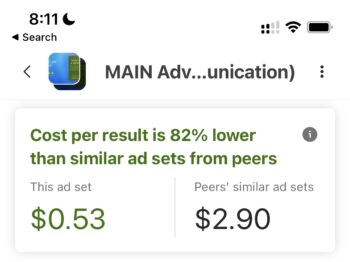
The 3:2:2 Dynamic Creative system
After some confusion and experimentation, I’ve found a campaign structure that works for iterating on ad creatives. It involves making Dynamic Creatives featuring three image, two headlines, and two body text options, and trusting Facebook to allocate spend according to which ads are most engaging. I’m following this YouTube video from Nick Theriot.
Tour of my Shopify store and Meta Ads on Patreon
If you want to see video tour of my Shopify store and Meta Ads setup, I’ve posted one for Patreon supporters.
Love Mondays passes 9,000 subscribers!
My Love Mondays newsletter recently passed the 9,000-subscriber mark. It started five years ago at around 7,300. It lost subscribers until it got as low as 5,600 in March 2021, and has grown 60% since then.
Now that I’ve quit the podcast, I can feel my creative energy being directed toward the newsletter. I have more time and energy to think harder about each week’s content, and think of new ways to improve and grow the newsletter. It’s one of my most-important assets and feels like one of my highest-ROI-activities, so I want to give it the attention it deserves.
That 9,000 includes much of the subscribers I’ve gained through the recent Facebook Lead Ads. Many of those contacts are still going through warm-up sequences before being added to Love Mondays. I hope to reach 10,000 subscribers sooner rather than later.
Experimenting with RSS campaigns / web archive
I’ve long wanted to have a decent web archive of my newsletters, but have always been confused how to go about this. Some email marketing platforms, such as ConvertKit, provide you with a web archive if you like, but I don’t like the idea of accepting someone else’s styling. I’d want it to be integrated with my website.
That then leads to the issue of how to syndicate the content. If you simply copy and paste so you send the same content in your newsletter as you post on your website, that feels inelegant: If you fix an error before it goes it, you have to fix it in two places.
So, I’ve been experimenting with accomplishing this through RSS. The idea is to have a section of my website where my newsletters are posted as if they were blog posts. A campaign on ActiveCampaign is then triggered by the RSS feed of those newsletters. So shortly after the content is posted to the website, it goes out via email.
Unfortunately, every email marketing platform I’ve seen treats RSS as a sort of afterthought. Both ActiveCampaign and ConvertKit have RSS-triggered campaigns, but the support is pretty limited, the documentation is incomplete, and their customer service teams don’t even know much about their RSS features.
Through some experimentation, I think I’ve found something that works. I’ve set it up on my staging server and run some tests, and worked out most of the kinks. I plan to try it out for my next batch of newsletters.
If all goes well, my newsletter system will be improved quite a bit. The workflow I envision would use an automation in my Airtable sheet to export a Markdown file to a folder accessible by Ulysses. I would then use Ulysses to export to WordPress (now that I think of it, best while I’m at it to see what kind of direct WordPress support Airtable has.)
This would bypass probably my least-favorite feature on ActiveCampaign, which is the campaign editor. After years of wrestling with annoying quirks to format emails, they released a new editor, which was no better. Being able to publish through WordPress instead would be a breath of fresh air.
Readers of this income report via email are hopefully enjoying a slightly better look, thanks to a re-vamped HTML template, populated via RSS.
Testing ActiveCampaign vs. ConvertKit deliverability
In the process of experimenting with RSS-triggered emails, I have been checking out ConvertKit once again, the email marketing platform which for years I’ve experienced some form of FOMO.
It’s kind of insane the creators they’ve been able to attract to the platform: James Clear, Mark Manson, Tim Ferriss, Ryan Holiday – everyone. I reached out to one very-high-profile creator who I recently noticed had moved there from ActiveCampaign to ask how it went. They essentially responded that they wished they had done it years ago, and that the deliverability is way better and the recommendation system has helped their list grow much faster. (Though they didn’t answer my question of whether CK had slid a suitcase full of coke across the boardroom table.)
I decided to test this deliverability claim for myself. I randomly selected subscribers who hadn’t opened some recent emails and re-sent the email to about 300 subscribers on both ActiveCampaign and ConvertKit. I made sure to set up and verify the SPF, DMARC, and DKIM settings for my domain with both providers.
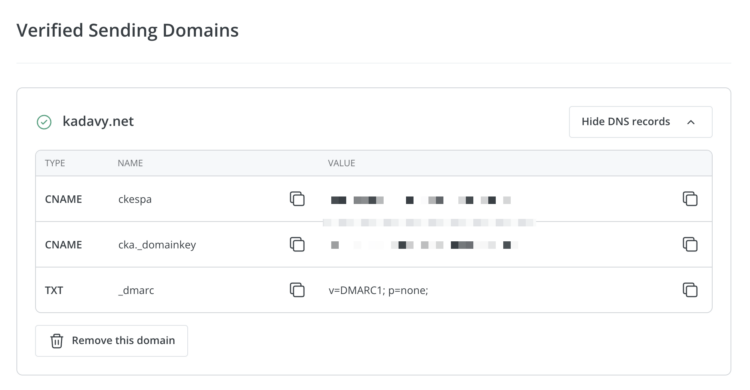
The results certainly alleviated much of my ConvertKit FOMO.
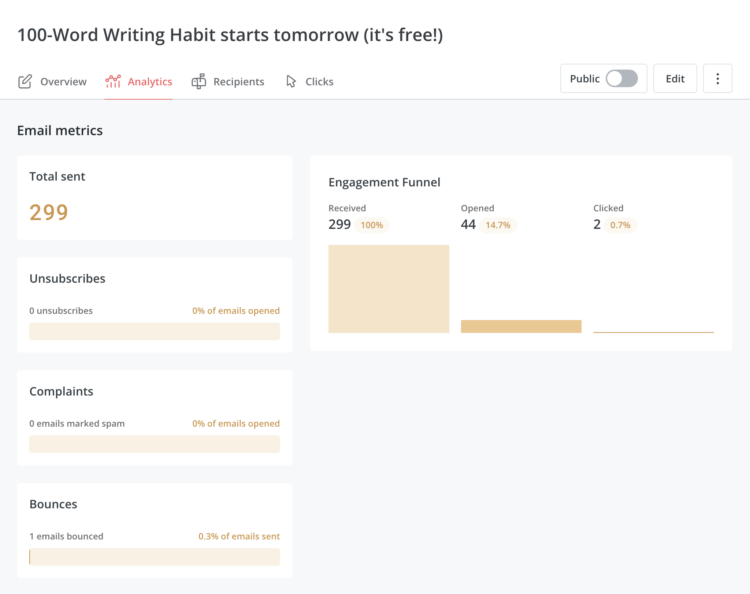
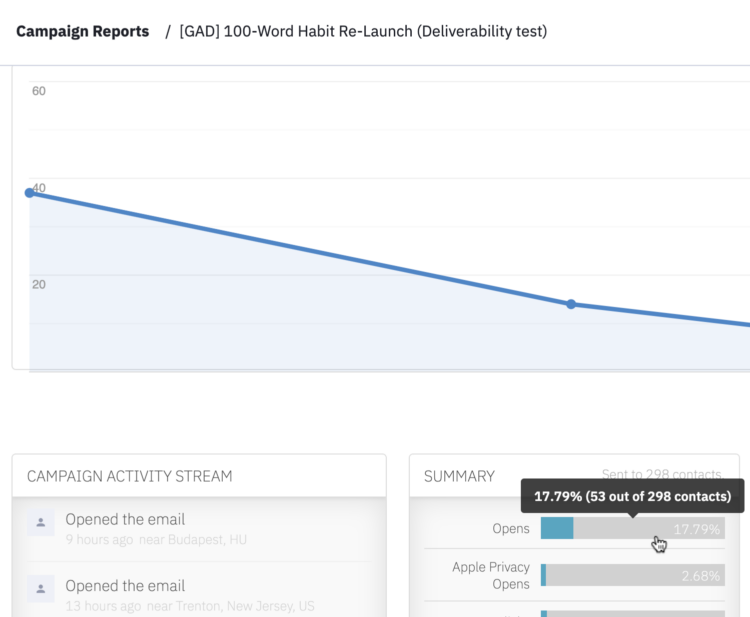
The open rate for these relatively inactive subscribers on ActiveCampaign was 17.79%. On ConvertKit, it was 14.7%.
Roughly 300 subscribers isn’t a lot of data, but according to a Bayesian calculator, there’s an 84.4% chance ActiveCampaign would win with more data.

Also, the ConvertKit campaign only generated two clicks on the relevant links, while the ActiveCampaign one generated nine unique clicks (ConvertKit doesn’t tell you whether the clicks were unique).
Conclusion: ConvertKit does not have better deliverability than ActiveCampaign
Long time readers will remember that I ran eight months of A/A tests and found many misleading “results.” I know better than to take this to mean that ActiveCampaign necessarily has a better deliverability rate than ConvertKit.
But it does tell me one thing: Even if ConvertKit does have a better deliverability rate than ActiveCampaign, it’s not dramatically better. (In fact, the evidence suggests AC has better deliverability than CK.)
There’s probably no better way to invoke FOMO about an email marketing platform than to claim yours has a better deliverability rate. Every email marketer worries on some level that their emails are simply not hitting inboxes, and that if they could magically fix that, their open rates would skyrocket.
For me, switching from AC to CK would not be that magical fix.
It’s weird, because if you search on Twitter, you’ll see many people saying their open rates went up when switching to CK. 🤷♂️
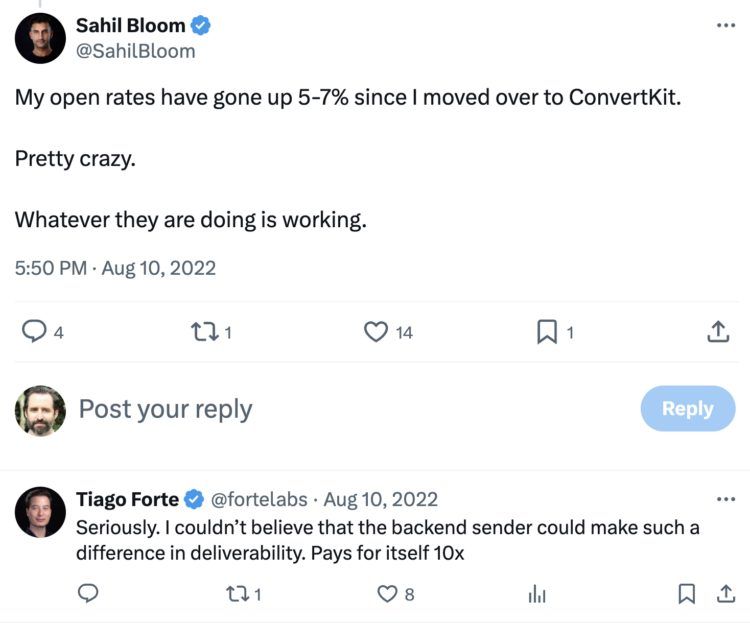
It’s worth noting that AC allows you to filter out “Apple Privacy Opens,” and doing so brings the open rate on this test down to 15.1% – which is still higher than the open rate on ConvertKit. Does ConvertKit count “Apple Privacy Opens”? Looks like it. ConvertKit’s article says their average open rates went up with new Apple privacy measures. But you can’t filter out those opens like on AC.
I do wonder if servers around the world have to be “warmed up” to accept my emails from ConvertKit. I’m looking into a longer-term test.
Trying out the ConvertKit referral network
Based upon playing with ConvertKit recently, I’m not planning to switch. I’m so familiar with ActiveCampaign after eight years, and have so many complex systems set up, CK would have to be several times better to justify a switch.
Don’t get me wrong, CK is great, but it’s so far not demonstrably better. In fact, I often find my hands tied playing with it. But in AC I feel like I can do anything.
However, I like the idea of CK’s creator referral network. Basically, you can “recommend” other creators, and other creators can recommend you. When you sign up for someone’s email list using a ConvertKit form, you are then presented with those recommendations.
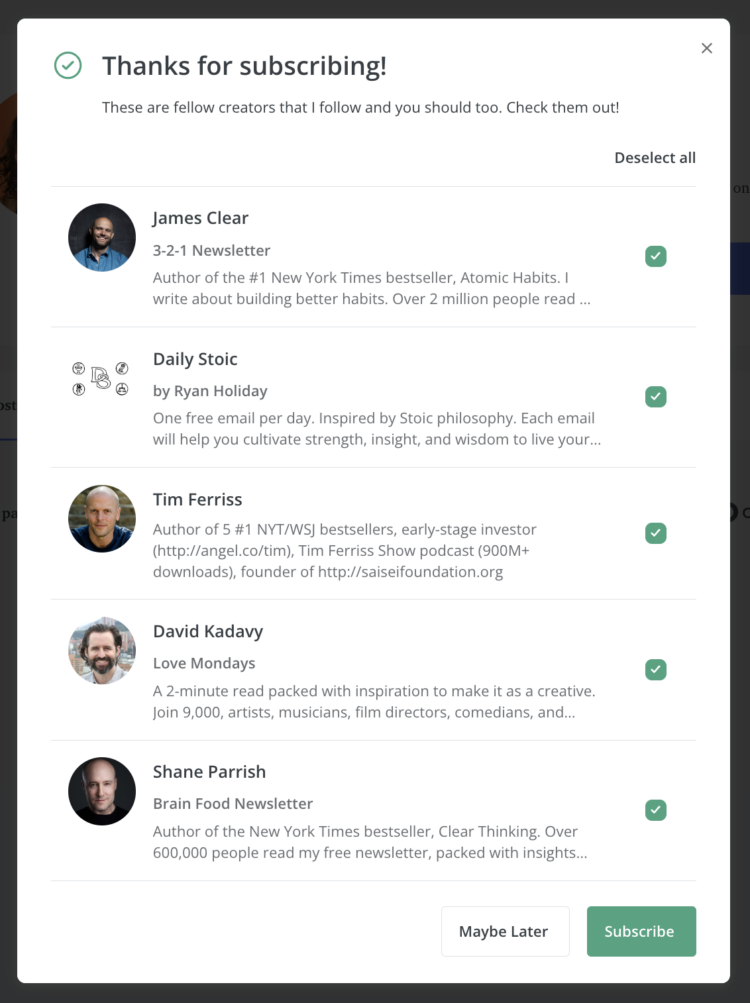
Since I’ve subscribed to CK to play with the features, I’m now in the creator network. If you’re a CK user and would like to recommend Love Mondays, please do!
Even if I don’t switch to CK in the long-term, in case this referral network proves to be useful, I’m brainstorming ways to use it long-term while still doing the majority of my email marketing through AC.
Record Shopify sales!
I had record revenue from my Shopify store this month. I made $1,076 from my Shopify store and the Facebook and Instagram stores it feeds. This is 18% of my books revenue. In December, I made a record (at the time) of $505, which was 8.7% of my books revenue.
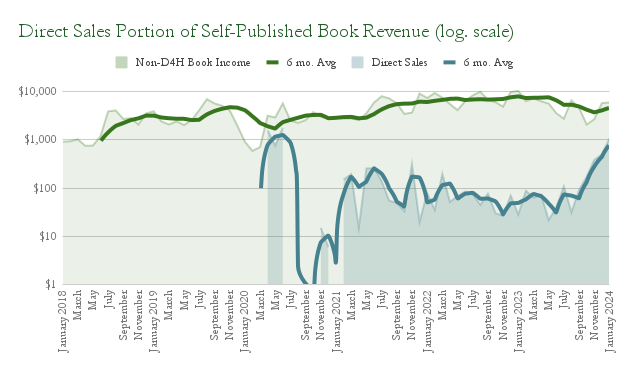 But, I spent $822 on printing and shipping books. Not to worry too much. $255 of that was from a top-up I did to my account balance in what I thought was February, but turned out to be the final hours of January.
But, I spent $822 on printing and shipping books. Not to worry too much. $255 of that was from a top-up I did to my account balance in what I thought was February, but turned out to be the final hours of January.
According to the report I made internally, I made $642 Gross Margin on these Shopify sales. I think that leaves me with about $130 of expenses which I’m not sure what were for. Maybe some combination of taxes and shipping discounts. 🤷♂️
I’m still iterating on how I assess and report my Shopify sales.
BookBub Featured Deal
I spent $857 on BookBub advertising. $649 of that was on a Featured Deal which didn’t start until February 2nd. Unfortunately I wasn’t able to put off charging it so it would be reported in the same month as the deal.
The rest of the BookBub Ad spend was on display ads. I ended up making dozens of campaigns and about a dozen creatives. I was able to achieve a high CTR, but I haven’t seen a commensurate amount of sales in my PublishDrive analytics yet.
The revenue from the Featured Deal will be in next month’s report, but I sold more than 650 copies for about $500 sales during the deal period. I don’t plan to analyze detailed numbers on sales of other titles or differences from baseline in the period before or after the promotion.
Austin networking trip
I’ve booked a trip to Austin! I don’t have a particular agenda in mind, but this is a part of my barbell strategy. I live mostly-secluded in a cabin in the mountains of Colombia, and I try to pepper in one or two highly-social trips each year. 20 Books Vegas was one, this will be another.
I’ve had some Austin FOMO lately, as it’s now a virtual Hollywood of online writers. I’m still working out how I’m going to make the most of my time there. Do you live there and would you be interested in some kind of online writers or self-publishing meet-up? I’ll be there March 30th through April 4th.
Reader interviews
I said earlier that I was in an exploratory phase of working on my next book. I’ve been doing reader interviews!
I sent an email to about 1,000 randomly-selected subscribers, with a Calendly link. So far I’ve met with twenty readers for 40-minutes each to talk about how they struggle with or think about finishing projects.
If you’re reading this you must be paying very close attention, so book a call!
Automating transcription/note-taking process
I’m very proud of the systems I’ve put in place for processing these interviews. Fireflies.ai creates a transcript, Zapier saves it to my hard drive, an Automator automation converts it from Word doc to Markdown, puts it in an Obsidian folder, and begins a note for me to write my own summary. When the meeting is over, another Automator automation converts the audio recording to MP3 for me to easily upload to Overcast to listen and review.
If you’ve ever struggled to make a useful automation in Mac OS’s Automator, ask ChatGPT for help. ChatGPT has really unlocked the potential of Automator for me!
100-Word Writing Habit possibilities
While 100-Word Writing Habit has overall been one of my less-successful short reads, it has been the top performer in my Meta ads. Which has me thinking maybe I have a good product with the wrong distribution.
I mentioned last week that I was trying out the 55% wholesale discount in IngramSpark. I can already see that so far in February 70 copies have been ordered by wholesalers. Wish I knew which was Amazon and which was, say, brick-and-mortar bookstores.
I have on my list of things to try listing HWH on Faire, which helps connect stores with wholesalers.
100-Word Writing Habit prompt journal?
I get lots of questions about writing prompts for HWH, so I’ve been considering a prompt journal. Not only would that help people get their 100-word habits started, it would also increase my Average Order Value from the Shopify store.
I’ve done a rough mockup of what an internal page might look like.
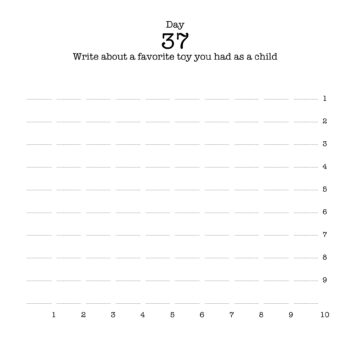
The idea would be to have a sort of “word-count calculator” test in the beginning of the journal, where you write a short statement, which helps you estimate at which point on the page you usually hit 100 words. In case a prompt gets you writing longer than the whole page, there would be “overflow” pages on which to continue. A habit tracker would help you get to 100 days of writing 100 words.
Sound neat?
Income
Book Sales
| Mind Management, Not Time Management Kindle | $667 |
| Mind Management, Not Time Management Paperback (Amazon) | $2,210 |
| Mind Management, Not Time Management (non-Amazon) | $749 |
| Mind Management, Not Time Management Audiobook | $479 |
| 100-Word Writing Habit | $569 |
| Digital Zettelkasten Kindle | $473 |
| Digital Zettelkasten Wide (non-Kindle) | $256 |
| Digital Zettelkasten Audiobook | $57 |
| The Heart to Start Kindle | $156 |
| The Heart to Start Paperback (Amazon) | $64 |
| The Heart to Start “Wide” (non-Amazon) | $105 |
| The Heart to Start Audiobook | $25 |
| How to Write a Book Kindle | $18 |
| How to Write a Book Paperback | $39 |
| How to Write a Book “Wide” (non-Amazon) | $115 |
| How to Write a Book Audiobook | $7 |
| How to Write a Book Spanish (all) | $4 |
| Make Money Writing on the STEEM Blockchain (all) | $4 |
| Ten Passive Income Ideas | $2 |
| Total Book Sales | $6,000 |
Digital Products
| Summer of Design | $0 |
| Total Digital Products | $0 |
Affiliates / Advertising
| Active Campaign | $302 |
| Alliance of Independent Authors | $16 |
| Amazon | $86 |
| SendOwl | $5 |
| Total Affiliates | $409 |
Reader Support
| Patreon | $152 |
| Total Reader Support | $152 |
Services
| Clarity | $0 |
| Medium | $0 |
| Total Services | $0 |
| GROSS INCOME | $6,561 |
Expenses
General
| Accounting | $0 |
| Book Printing | $822 |
| Outside Contractors | $0 |
| Quickbooks | $27 |
| Total General | $849 |
Advertising
| Amazon | $654 |
| BookBub | $857 |
| $5 | |
| Meta | $1,030 |
| Influencer Marketing | $0 |
| Product Samples | $0 |
| Total Advertising | $2,547 |
Hosting
| ActiveCampaign | $135 |
| Bookfunnel | $15 |
| Drafts | $2 |
| Dropbox | $10 |
| Fathom Analtyics | $14 |
| Libsyn | $5 |
| Namecheap | $32 |
| Obsidian Publish | $10 |
| SendOwl | $9 |
| Shopify | $5 |
| Ulysses | $3 |
| WP Engine | $96 |
| Zapier | $14 |
| Total Hosting | $350 |
| TOTAL EXPENSES | $3,745 |
| NET PROFIT | $2,815 |


